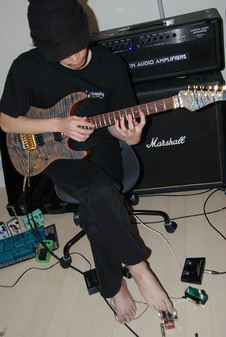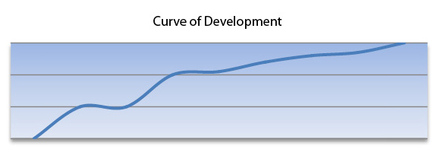
My pedal endorser Shun Nokina (brand "Leqtique") shredding away on some of his new creations!
Expect great things to come! Also note the mighty board of "MAR" casing ready for assemble behind him
 My pedal endorser Shun Nokina (brand "Leqtique") shredding away on some of his new creations! Expect great things to come! Also note the mighty board of "MAR" casing ready for assemble behind him
1 Comment
Below is a post from my blog at Infinite Guitar.
“Open blog post to Scott1793” Reading a question from one of our members, Scott1793, got me thinking, and prompted me to write this blog post. Scott’s question was short and simple “What is the best way to train your ear so you can play what you hear in your head instantly on the guitar??????” I want to address this “answer”, or rather my thoughts on the subject, to Scott, and everyone else that might have this problem. First thing Scott, if you can't sing what's in your head, there's little chance you'll get it out through your fingers so to say. SO, one initial exercise would be to practice improvisation over more melodic backings (such as those on gilmourish.com) and SING every little thing you play. Step by step, your ear will improve, and the gap between what you hear in your head and what you play will narrow. Of course there are many other steps and measures to be taken. Timing and note value alteration is a KEY concept to be able to accurately "translate" what's in your head. It will act like a focal point for your mind as well as your practical playing. You see, in the formative years as we strive to play "what we hear in our head", one of the big problems is that what we actually hear is so out of focus and fragile. Let me ask you a question Scott. Have you had the experience of having a crystal clear line or idea in your head, both melody and rhythm? I'm sure you have or you wouldn't ask this question Have you then tried to transfer this idea to the guitar and as you try to find it, and can't, you will find that you can't remember the original line in your head anymore? Is it as if actually trying to play something on the guitar “erases” what was in your head? More often than not, it IS that fragile. I clearly remember sometimes waking up in my teens, having this vivid “dream-like” musical idea in my head, only to find myself utterly unable to capture it once reaching for the guitar, it was just like catching mist! You often read stories of guys like Mozart, or Zappa even, and other great musicians and composers being able to sit with a piece of paper and just write down the music that was in their head, even massive orchestral scores, being able to visualize every single note and instrument in their mind’s eye! Now wouldn’t THAT be something! That ability and level of connection to our inner music is so very rare though, that it will never be more than a dream for most of us. However, practicing singing our lines and ideas, can and WILL bring us closer to reaching our OWN potential. Having a good ear for music, being able to sing a line, and repeat on your instrument, being able to sing notes and intervals solely by ear, and even such clashing intervals as a minor seconds is essential to be able to play what you hear in your head. Above I mentioned having timing, and singing as a focal point. What will happen as you practice such things is not so much that your fingers will get better finding the right notes. It is rather that you will “train” your inner ear to achieve great focus and conditioning. This means that your inner ideas, even though coming from a place of creativity will be more “organized” and easier to translate. Organizing and training your inner ear is not easily achieved, and takes time and patience, but it can be done, and is in my opinion THAT much more important than practicing technique day in and day out. So Scott, to be concrete and summarize some advice and exercises for you I would make this list.
This would be an initial exercise. Then adding rhythm exercises and more advanced exercises will just develop your ear even further. Then, start singing AS you play over these progressions. Also pay attention to the rhythm of your singing, this is as important to be able to flat out improvise what’s in your head. Of course, IF you want to take this ability to the next level, you would need to sing and play over more advanced progressions and scales, but the key is SINGING! Even advanced jazz players does it all the time, and especially when starting out, singing lines you want to learn in jazz is KEY. This way you will hear the chord at the same time as you hear your voice in your own head. This is COMPLETELY different from just playing and hearing your guitar and the chord. When singing, you get a “feel” inside your head how the melody rests or acts against the chord, which is a very different way of listening, ACTIVE listening, rather than the passive listening of noodling through scales you theoretically know are right over a chord. Enough rambling for this time guys, see you soon again =) //Richard Related lesson at Infinite Guitar: Ear Training for Greater Musical Proficiency Tutorial Perception vs. Harmonic Context Tutorial  Below is a post from my blog at Infinite Guitar. As guitarists and musicians we all strive to develop, to go further, learn more, play faster, better etc. Throughout my years as a teacher I’ve come to see many very talented (and some not so talented) kids pass me by. Most follow the same curve of development, starting with the wish to be able to play the songs of their idols, be it Iron Maiden or Wilson Picket. Once they’ve started to learn a few riffs and songs of their favorite bands, most turn to improving their technique within that field of music. This is where things get interesting and where many factors play part. One thing that play part is of course inherit musicality. We are all born with different gifts be it musical, mental or physical. Some might have the makings of remarkable musicians, but being brought up in a non-musical environment they will never be subjected to the igniting factors and thus never develop those gifts. But such things aside everyone can and should strive to make the best they can with the tools they’ve been given. Only focusing on technical development (regardless of musical style) will in most cases lead to a steep curve of development, where the guitarist is proficient in playing the songs of their idols, or even things in that genre, in some cases like a robot. In this case they give out only what’s been put in, not being able to utilize their technique to much more than playing the music of others as it was written (with various degrees of proficiency). What I strive to provide my students with, more so than technical excellence, is depth and the conceptual understanding of how to utilize their technical proves in a wide range of musical contexts. The idea is to sound professional and experienced regardless of where on the technical curve of development you might be. Instead of having an audience go “man, ‘he’s fast and technical”, go “Jeeez, that guy sound SOO good!” Conceptual thinking and application is a key here, to be able to “milk” every idea and technical quirk you might have in storage. By focusing as much on learning timing and note value variation, you can alter any of their ideas to sound more proficient over the tune their playing. Just using technically comfortable speeds will just sound like you’re not really listening to what you’re doing.  Once you got a good sense of the concept of timing and note value alteration, it’s time for application! A big part of this is having every little thing you’ve learned immediately accessible “at your finger tips” so to say. Many times guitar players spend literally hundreds of hours learning techniques and licks, which may sound great when played over the context they we’re learned in. The problem is however, that more often than not, they can’t use them outside that context, thus having what I call the “ice-berg syndrome”. That is, having a huge load of material you’ve learned, but 80% of it is hidden under the surface, and only the tip of the iceberg is at your disposal. A very simple, yet incredibly effective tool to remedy this is to simply learn a favorite solo from any song you like, for sake of argument let’s say the solo to “You Shook Me All Night Long” by AC/DC. It’s a pretty straightforward rock solo in the key of G, with a straight 16-note beat feel to it. Then take the song “Strange Kind of Woman” by Deep Purple. This is in the key of B, and has a triplet shuffle feel to it. Now transpose the AC/DC solo to the key of B and play it over the Purple tune. Sounds fairly simple right? Well, the trick is to adapt it rhythmically to fit the song, that is play the solo not as Angus would have, but make it sound like Blackmore would have done it. You need to be able to add rests, change note values within the lines of the solo, and be able to improvise rhythmically, while using the licks from the Shook Me-solo. You should be able to take it to the point where anyone listening should not think that you’re playing the AC/DC-solo even if they know the song. If you keep applying this concept of timing, note value variation and “Superimposing solos”, eventually your curve of development will “fill up” below the line. This way, regardless of where on the curve of technical development, you will sound proficient, experienced and hopefully the “Jeeez, that guy sound SOO good!” will come at you left and right =) Kampai! //Richard Related lesson at Infinite Guitar: Timing and Note Value Alteration Tutorial Expand Your Improvisation with Line Alterations Tutorial Welcome to the Fretdance blog guys!
In this blog I plan not only to share tidbits and every day events, but also more extensive posts on music in general and guitar playing in particular. Please feel free to post comments! |
Archives
April 2013
Categories
All
|